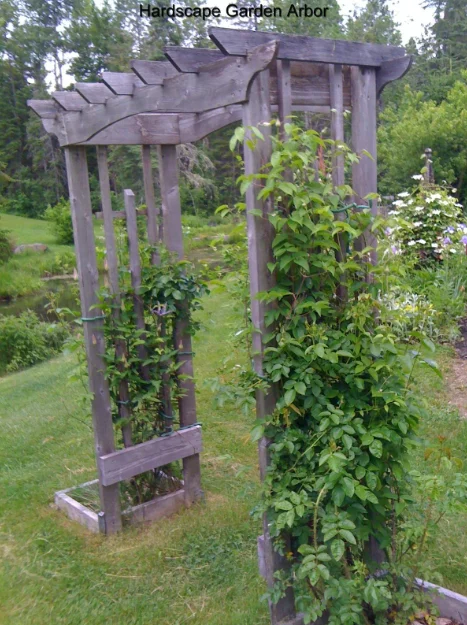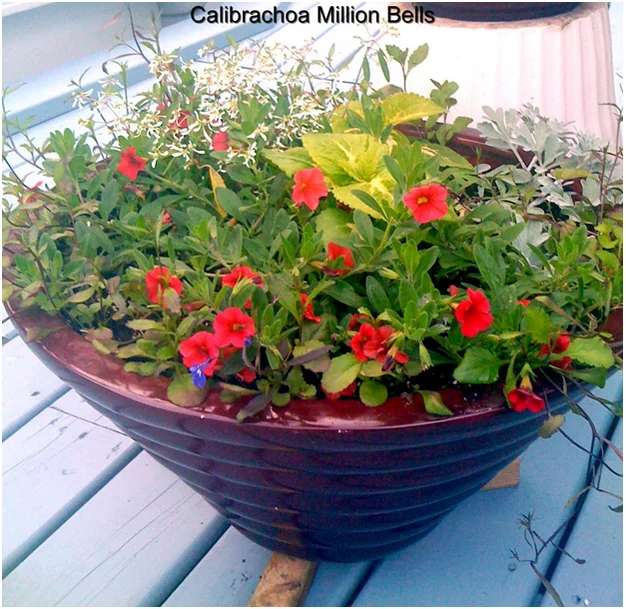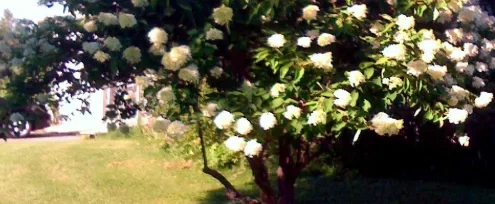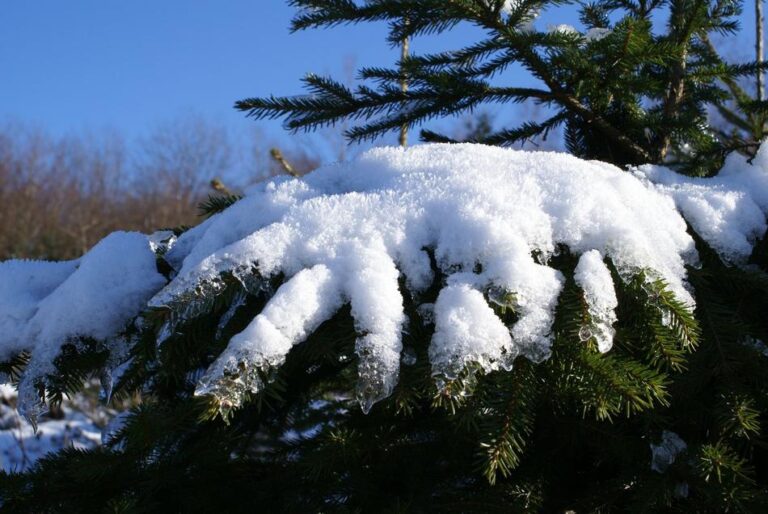Gardening like most other hobbies has a language of its own. There are terms related to plant growth and development and garden practices. There is also the extensive use of Latin to name plants. There are common names for plants; these vary from place to place so Latin provides a common denominator that enables people to understand what plant the other is speaking about.
Hardscape and softscape
Hardscaping generally refers to items in the garden that are not alive and have been purposely installed in the space: statuary (like the rhododendron art installation in the Fredericton Botanic Garden), fountains, garden artwork, rock walls, fences, trellises, arbors, and obelisks are examples. Often these items remain in the garden all year and thus add to the garden picture in late fall and winter when herbaceous material is resting. Some of the larger hardscape items like retaining walls, walkways, wooden structures, large artwork and fountains will likely be placed before any plant material. In the garden hardscaping provides the “bones” or supporting frame of the garden, it can emphasize garden “rooms” and provide points of interest that lead the eye into the garden spaces. Planting beds, shrubs, vines and trees form the living or softscape parts of the yard. These two are the elements of the landscape.
Biennial
A biennial plant typically has a two year lifespan. The first year the plant starts from seed and produces vegetative growth and organs to store food. The next year the plant blooms, sets seed and dies. Examples of biennials include Sweet William, Hollyhock and Canterbury bells. Garden vegetables like the carrot, beet, and cabbage are also biennials.
Tender perennial
In our Zone 4 and 5 gardens, many plants cannot survive winter. In their ‘home’ zones, though they are perennials. These are tender perennials. Most tender perennials are either grown as annuals and discarded or composted in the fall or brought inside to overwinter in cool spaces or in the living space in the home. Calibrachoa, Million Bells and Diascia, twinspur both popular plants for hanging baskets, are tender perennials.
Dioecious
A dioecious species of plant has male flowers on one plant and female flowers on another. Holly and hardy kiwi are examples. If you want holly berries or fruit produced make sure you purchase both a male and female plant. There are also hybrids which have a male and a female grafted on the same plant.
Flowering on new wood
These plants produce blooms on the current year’s growth. Since growth takes a little time, these are usually summer and fall blooming plants. Trim these type plants in early spring before growth is started. Examples are Clethra alnifolia, Summersweet, Hydrangea paniculata, Peegee Hydrangea and Potentilla fruticosa, Potentilla.
Flowering on old wood
These plants produce blooms on the last year’s growth and are typically spring bloomers. Trim these just after the flowers are finished. Trimming in late summer or fall will decrease or eliminate next year’s blooms. Examples are Syringa species, lilacs (seen in the bedding area near the rhodo garden, at the Fredericotn Botanic Garden).Philadelphus species, Mockorange and Forsythia.
Own root plants
These are plants that have their own root system as compared to plants where a scion is grafted to the stock and roots of another plant. Typically apple trees are grafted as are hybrid tea roses and tree peonies. There are tree peonies in the peony garden, at the FBG. Many of best winter-hardy roses are “own root”.
Root bound
This occurs when the plant roots have filled the pot in which they are contained, and can no longer function to their capacity. The plant needs to be repotted in the next larger sized pot. The roots need to be teased or moved apart so that they can push out into the space afforded by the new container.
Ball and Burlap
Plants are dug from the ground so that the soil surrounding the roots is undisturbed. The root ball is then wrapped in burlap to keep the soil in place. Before planting, the wire holding the burlap and as much of the burlap as possible should be removed.
Bare Root
Some plants are sold without soil around the roots. When you purchase material like this, closely follow the instructions sent by the grower. Often the material should be kept as cool as possible until it can be planted and the roots can benefit from soaking for several hours in water before planting. Much of the plant material purchased for the FBG Plant Sale is purchased bare root.
Hardscape and softscape
Hardscaping generally refers to items in the garden that are not alive and have been purposely installed in the space: statuary (like the rhododendron art installation in the Fredericton Botanic Garden), fountains, garden artwork, rock walls, fences, trellises, arbors, and obelisks are examples. Often these items remain in the garden all year and thus add to the garden picture in late fall and winter when herbaceous material is resting. Some of the larger hardscape items like retaining walls, walkways, wooden structures, large artwork and fountains will likely be placed before any plant material. In the garden hardscaping provides the “bones” or supporting frame of the garden, it can emphasize garden “rooms” and provide points of interest that lead the eye into the garden spaces. Planting beds, shrubs, vines and trees form the living or softscape parts of the yard. These two are the elements of the landscape.
Biennial
A biennial plant typically has a two year lifespan. The first year the plant starts from seed and produces vegetative growth and organs to store food. The next year the plant blooms, sets seed and dies. Examples of biennials include Sweet William, Hollyhock and Canterbury bells. Garden vegetables like the carrot, beet, and cabbage are also biennials.
Tender perennial
In our Zone 4 and 5 gardens, many plants cannot survive winter. In their ‘home’ zones, though they are perennials. These are tender perennials. Most tender perennials are either grown as annuals and discarded or composted in the fall or brought inside to overwinter in cool spaces or in the living space in the home. Calibrachoa, Million Bells and Diascia, twinspur both popular plants for hanging baskets, are tender perennials.
Dioecious
A dioecious species of plant has male flowers on one plant and female flowers on another. Holly and hardy kiwi are examples. If you want holly berries or fruit produced make sure you purchase both a male and female plant. There are also hybrids which have a male and a female grafted on the same plant.
Flowering on new wood
These plants produce blooms on the current year’s growth. Since growth takes a little time, these are usually summer and fall blooming plants. Trim these type plants in early spring before growth is started. Examples are Clethra alnifolia, Summersweet, Hydrangea paniculata, Peegee Hydrangea and Potentilla fruticosa, Potentilla.
Flowering on old wood
These plants produce blooms on the last year’s growth and are typically spring bloomers. Trim these just after the flowers are finished. Trimming in late summer or fall will decrease or eliminate next year’s blooms. Examples are Syringa species, lilacs (seen in the bedding area near the rhodo garden, at the Fredericotn Botanic Garden).Philadelphus species, Mockorange and Forsythia.
Own root plants
These are plants that have their own root system as compared to plants where a scion is grafted to the stock and roots of another plant. Typically apple trees are grafted as are hybrid tea roses and tree peonies. There are tree peonies in the peony garden, at the FBG. Many of best winter-hardy roses are “own root”.
Root bound
This occurs when the plant roots have filled the pot in which they are contained, and can no longer function to their capacity. The plant needs to be repotted in the next larger sized pot. The roots need to be teased or moved apart so that they can push out into the space afforded by the new container.
Ball and Burlap
Plants are dug from the ground so that the soil surrounding the roots is undisturbed. The root ball is then wrapped in burlap to keep the soil in place. Before planting, the wire holding the burlap and as much of the burlap as possible should be removed.
Bare Root
Some plants are sold without soil around the roots. When you purchase material like this, closely follow the instructions sent by the grower. Often the material should be kept as cool as possible until it can be planted and the roots can benefit from soaking for several hours in water before planting. Much of the plant material purchased for the FBG Plant Sale is purchased bare root.


`





